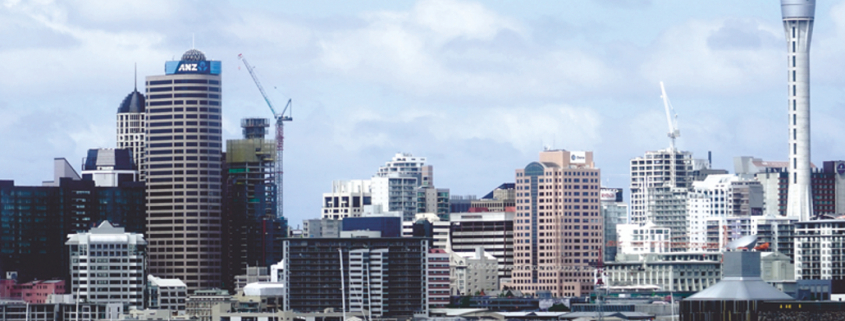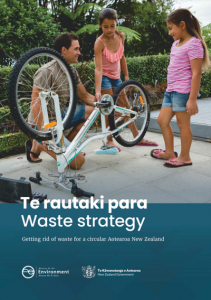New Zealand’s Te Rautaki Para / Waste Strategy
In March this year, the New Zealand Ministry for the Environment published a new waste strategy for the country.
The document results from several initiatives including a consultation process, in which the New Zealanders could have their say on proposals to bring the country’s recycling systems up to standard. Furthermore, the strategy had been prepared – inter alia – taking account of the government’s decisions on waste and the circular economy, progress on individual projects across the waste work program, proposals to transform recycling, proposals for the new waste legislation, and the enhanced systems for managing investment to minimize waste. The same applied to emerging issues, including the rapidly growing interest in the potential of chemical recycling, waste-to-energy technologies and bio-economy and renewable energy possibilities.
The waste situation
In 2021, it was estimated that in Aotearoa (the current Māori-language name for New Zealand) the annually generated waste amounted to 17.49 million tons, of which an estimated volume of 12.59 million tons was sent to landfill. As per the Ministry for the Environment, this estimate includes waste disposed of in landfills, clean fills, and farm dumps. It would also include the materials recycled in New Zealand and those sent offshore for recycling.
Waste sent to “class 1” landfills (that accept household waste) had increased by 47 percent from 2,499,571 tons in 2009/2010 to 3,682,419 tons in 2018/2019, with per capita waste increasing from 580 kilograms to 740 kilograms per year. As reported by the ministry, there was a slight decrease in waste in “class 1” landfills in 2019 and 2020, with the decrease in 2020 mainly due to Covid-19. However, longer-term trends would suggest that the waste disposal rate would increase.
“Solid waste is not the only problem,” Environment Minister David Parker wrote in the strategy document. “The way we produce, manage and dispose of things also generates emissions of greenhouse and other gases“. In 2020, waste contributed to around four percent of the country’s total greenhouse gas emissions and around nine percent of its biogenic methane emissions; 94 percent of these emissions were caused by decomposing organic material in landfills.
“Many of the products we use aren’t built to be repaired, and, even when they are, it’s often cheaper to throw them away and replace them, rather than source parts (if they’re available),” the minister underlined. New Zealanders care about this and were rightly demanding change. “The waste sector agrees that change is needed and recognizes the opportunities from catching up with the world’s best-performing countries.” Therefore, the goal is to achieve the vision of Aotearoa New Zealand as a low-emission, low-waste society, embedding circular economy principles by 2050.
The phases of getting rid of waste
In line with the strategy, there are three phases to achieve the planned circular economy:
- By 2030, New Zealand’s systems are working well, and people’s behavior is changing. More activity is circular, and the country produces less waste.
- By 2040, circular management of materials is normal, expected and well-supported. The amount of residual waste is low, while emissions and other environmental indicators are improving.
- By 2050, the country has reached its aim and is helping other countries make the change. While domestic systems are as circular as possible, New Zealand contributes to Pacific and international circular networks. The management of materials does not harm the environment.
Funding and investments
In order to enable the targeted change, eight objectives were formulated, which are to be realized by 2030. Goal 1 involves new or improved systems for regulation, investment, planning and reporting, data collection, and more. Apparently, the waste disposal levy can generate significant funds to help achieve this strategy. “Other public funding is also made available for waste minimization initiatives from time to time,” the Ministry for the Environment gave account. “Much of our work on establishing good underlying systems relates to ensuring we can effectively manage this funding and investment.” The ministry had already redesigned the processes for its increased investment activity using the “Waste Minimisation Fund”, “Plastics Innovation Fund” and Covid-19 recovery funding. The next step would be to align the central government investment framework to this strategy. Other priorities would include improving access to funding for Māori as well as attracting more investment partners and sources of capital, including other central and local government agencies and the private sector, to name but a few.
Another goal is getting the equipment and infrastructure in place that the country needs for a coherent, nationwide network of facilities for the collection and circular management of products and materials. The New Zealand Government provided funding for new and upgraded infrastructure in recent years, but further investments are necessary. According to the information provided by the strategy document, between two billion New Zealand Dollar (about 1.3 billion US-Dollar) and three billion New Zealand Dollar (nearly 1.9 billion US-Dollar) would be required by 2030. “The revenue generated by the expanded waste disposal levy provides a good start for the investment needed in circular resource infrastructure, but we cannot wait for the levy to generate that level of funding on its own,” the ministry wrote. “Because the private sector participates extensively in the waste management sector, it is appropriate that it also invests in the solutions. In general, public funding should be used to fill gaps or kickstart facilities and services that the market struggles to provide; it should not displace private sector investment and activity.”
Circular resource management is a growth area with significant scope for innovation, the ministry underlined. Opportunities would exist for iwi (the tribal entities of the Māori people) and other new investors to get involved and support new infrastructure, industries and jobs, locally and regionally. “Central Government will manage the investment of its levy funds to leverage funding from other sources and work with other Government investment vehicles, where appropriate.”
Recovery Systems
A further aim is dedicated to recycling and involves creating a consistent recycling service across the country for materials. One of the priorities is to simplify material streams so more can be recycled. The government can support change in this area by:
- encouraging and funding research and innovation on better ways to use recyclable materials;
- setting design standards that control the composition of some products or packaging (this is included in the proposed new waste legislation);
- requiring manufacturers and suppliers to provide consumers with clear information on recyclability, so they can make informed choices when they buy things, which will create pressure for businesses to change;
- removing hard-to-recycle materials from the national economy.
Apart from strengthening the collection systems and services across the country and getting New Zealanders recycling correctly, the market demand for recycled materials is a priority in this area. “Currently, there are few or no takers for some recycled materials; for other materials the markets are volatile. However, in some cases (such as metal), the market is reasonably effective and stable,” the ministry stated. That would be another area where everyone has a role. Customers at any stage of a supply chain could have an influence. “For example, businesses that manufacture things, or use packaging, can demand materials that contain more recycled content.” In addition, the government could fund research and innovation, which supports markets and infrastructure that supply or use recycled material. The proposed new waste legislation would also give power to the government to require a proportion of recycled content in specified products.
Since waste management organizations are the primary investors in waste collection and processing infrastructure and facilities, they “need a reliable supply of material to recycle, affordable technology to process it, and a steady demand for what it produces”. At present, “this balance is fragile, but the changes set out in this strategy should redress that balance over time”. Finally, yet importantly, the New Zealand Government is looking for ways to recover any remaining value from residual waste that cannot be recycled and is destined for final disposal. “Although recovering value is near the bottom of the waste hierarchy and should not displace options further up, we will continue to have residual waste for some time. This is a challenging area that we must approach cautiously, but if we can use truly residual waste without harming the environment we should do so.” The opinion forming regarding a balanced and consistent approach to recovering value from waste across government and industry strategies, policies and actions is not yet completed.
The New Zealand waste strategy: environment.govt.nz/publications/te-rautaki-para-waste-strategy/
(Published in GLOBAL RECYCLING Magazine 2/2023, Page 4, Photo: Bernd Hildebrandt / pixabay.com)







